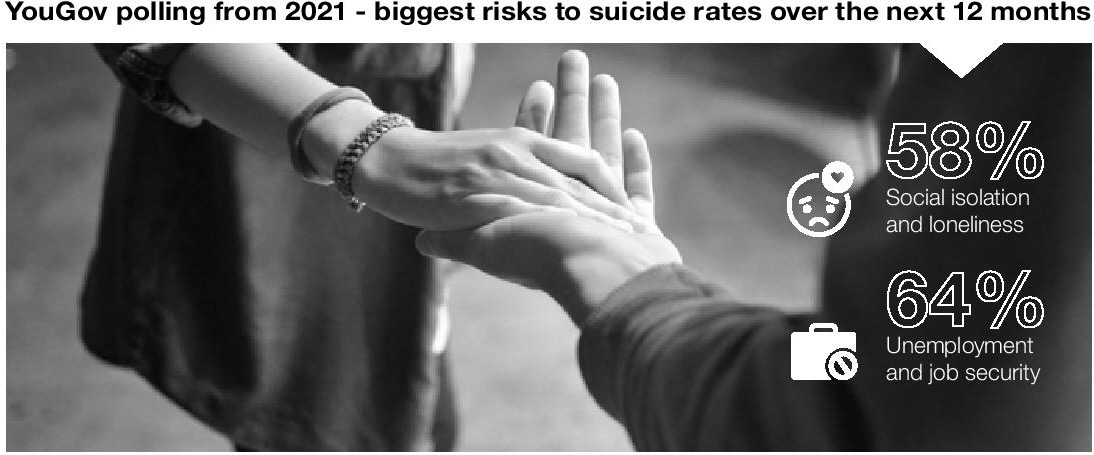MELBOURNE, 10 September 2021: A record number of Australians are seeking help from suicide prevention services, says the report ‘State of the Nation in Suicide Prevention 2021’ released today. Prepared by ‘Suicide Prevention Australia’, the national peak body providing support for Australia’s suicide prevention sector for more than 25 years. The key message of the report is – ” suicide prevention is everyone’s business.”
On page 4 the report says, “We can also clearly see from the data in this report that it’s a sector under great strain. It’s been another difficult year for our community and we’ve seen record demand many of the supports our sector delivers. There’s uncertainty around funding and uncertainty about the future.
The message is a simple one: we need to help those who help our community. The many thousands of people working in suicide prevention are facing increasing pressure and while additional investments from Government are welcome, they need to keep pace with increasing demand and put our sector on a sustainable footing.”
Suicide Prevention Australia CEO Nieves Murray says young people were seeking help at twice the rate of their parent’s generations, following decades of awareness-raising, stigma reduction initiatives, and advocacy.
“Creating hope through action is an important part of World Suicide Prevention Day and every other day of the year,” Ms. Murray said.
The report shows 84% of suicide prevention services and workers experienced an increase in demand in the past 12 months (August 2020 to August 2021). This is an increase of 78% (+6pp) in the same period last year.
“It’s a highly collaborative sector with 75% of respondents working in partnership with Government or other organizations.
“The sector is united in urging a whole-of-government approach to suicide prevention, with 95% of respondents supporting this reform.
The State of the Nation in Suicide Prevention report shows 85% of the suicide prevention sector support all government decisions considering and mitigating suicide impacts – which a national Suicide Prevention Act would deliver – as well as 67% of Australians.
In the community, 29% of Australians report they discussed suicide concerns about themselves or with someone else over the same 12-month period.
This includes young people (18- 34) reporting having conversations about suicide (40%) and seeking help (41%) at twice the rate of their parent’s generations (20% and 19% respectively).
Australians report taking action to seek help from a suicide prevention service (27%).
Royal Australian and New Zealand College of Psychiatrists (RANZCP) President, Associate Professor Vinay Lakra, said addressing workforce shortages and funding consistency would also help.
“We have a significant shortage of the psychiatrists needed to service the country’s mental health needs. This has only been further exacerbated by the surge in mental health demand during COVID-19, with wait times as long as nine months.
“Workforce shortages can be addressed with the enhancement of a multidisciplinary workforce underpinned by incentivized multidisciplinary collaboration.
“It is important that we continue to monitor the situation and continue to enhance and improve service provision to address the inequity within the system and provide services to those who need it, when and where they need it,” Associate Professor Lakra said.
The State of the Nation in Suicide Prevention report found 71% of suicide prevention services do not believe services for priority populations are appropriately funded. Only 3% did.
Key findings from the State of the Nation in Suicide Prevention Report include:
· Two-thirds (66%) of Australians agree that Australia should introduce a standalone Suicide Prevention Act similar to Japan that looks to take a whole-of-government and not just a health approach to suicide prevention. Just 8% disagree with this sentiment.
· Suicide arises from a complex interaction between many vulnerabilities, risk factors and triggers in a person’s life. According to sector respondents, the greatest risk to suicide rates over the next twelve months are posed by social isolation (88%) and unemployment and job security (74%), followed by family and relationship breakdowns (69%), cost of living and personal debt (57%) and housing access and affordability (56%).
· This aligns with public sentiment, with the Australian public considering the biggest risks to suicide rates over the next 12 months as social isolation and loneliness (64%), unemployment and jobs (58%), family and relationship breakdown (57%), cost-of-living (55%), drugs and alcohol (53%), housing access and affordability (36%), ageing, retirement and savings (20%), health and fitness (16%), gender roles (13%), new technology and social change (12%), and climate change (11%).
· Female public respondents were significantly more concerned about suicide risks in all of the top categories compared to men, including social isolation and loneliness (70% vs 58%), unemployment and job security (64% vs 53%), family and relationship breakdowns (62% vs 52%), cost of living and household debt (61% vs 50%), drugs and alcohol (56% vs 50%), and housing access and affordability (39% vs 32%).
“The 2021 Suicide Prevention Australia State of the Nation report was based on 283 responses from suicide prevention and mental health sector organizations. It also includes public survey results commissioned by Suicide Prevention Australia from YouGov plc. The total sample size was 1049 adults. Fieldwork was undertaken between 19th – 22nd August 2021. The survey was completed online. The figures have been weighted and are representative of all Australian adults (aged 18+)”, says a medianet press release.







